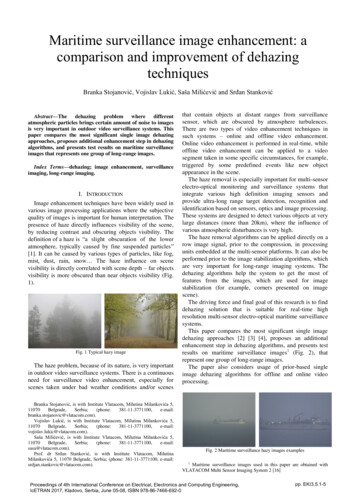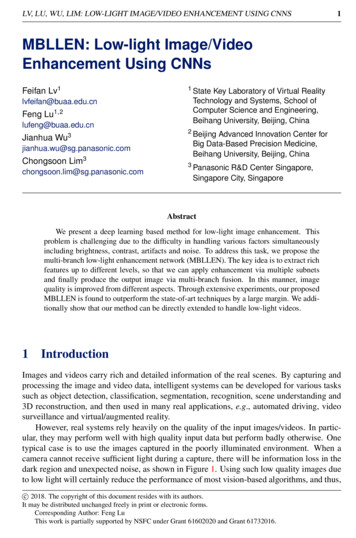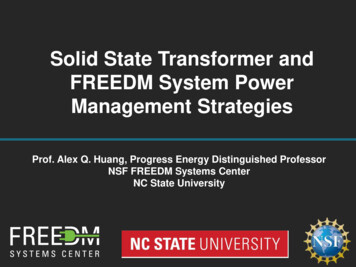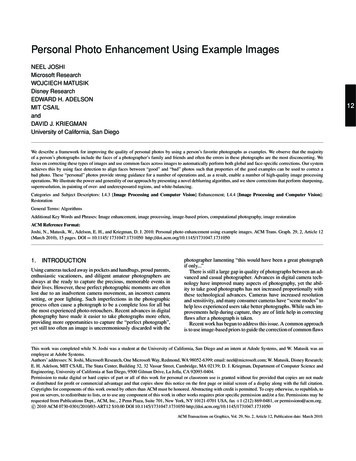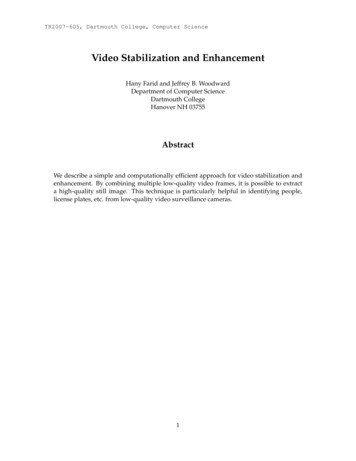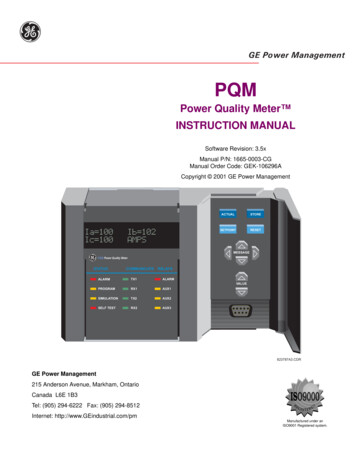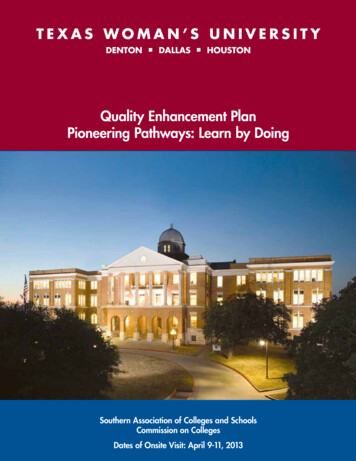
Transcription
International Journal of Inventive Research in Science andTechnology Volume (1), Issue (1), August2022POWER QUALITY ENHANCEMENT OF A GRID LINKEDSOLAR/WIND HYBRID POWER SYSTEMSumit Kumar1, Gunjan Mishra2,Vasant Acharya3Gmail- aryatitc@gmail.com31M.Tech Scholar, Department of Electrical and Electronics Engineering, Technocrats Institute ofTechnology, Bhopal, India2M.Tech Scholar, Department of Electrical and Electronics Engineering, Technocrats Institute ofTechnology, Bhopal, India3Associate professor, Dept.of Electrical & Electronics Engineering, Technocrats Institute ofTechnology,Bhopal, IndiaABSTRACTThe power electronics converters (PECs), which are the primary control component for combining a variety ofresources into a micro grid, serve as a basis for the new renewable energy-based power system. This Paperpresents a PV/wind system interface and uses a power converter to link a hybrid PV/wind system to grid. Basedon the load's voltage and harmonic content, the integral power converter topology employs various generatorsand control strategies to supply the load. The analysis of the solar power and WPGS interface is the primarygoal of the findings is to regain grid attributes. The grid Values and the PV/Wind hybrid system Values canboth be controlled by the same controller. Consequently, the movement of real and reactive power at PCCbecomes smooth.KEYWORDS: Alternative Energy Sources (AESs) Permanent Magnet Synchronous Generator (PMSG),Point of Common coupling(PCC), power electronics converters (PECs), solar generation, Wind generation.1. INTRODUCTIONThe majority of AESs are dependent on their environment, hence they have unpredictable and changingproperties. However, their environmental friendliness makes them very popular for power generation inthe current, severe global warming crisis. The typical low efficiency of AES as compared to traditional generating indicates another huge obstacle to its widespread adoption. In order to integrate various sourcesand create a hybrid system that is more dependable and sustainable, a promising technology is needed [1].The appropriate option is the integration of several AESs with one another and with PECs in utilitysystems [4,5],the new fields of research that is expanding the possibilities for simple, effective, and reasonable power generation and utilisation of AESs is the fast growing in the technology of PECS for integrating AESs as compared to traditional power sources [2, 3].The most potential AES as a green energy supplement are wind and solar . They are rapidly becoming thegreen energy sources that can meet the fast changing demand for energy and have much smaller carbonfootprints than conventional energy sources. Although being in high demand, solar and wind power eachhave their own disadvantages. Specialized equipment is needed to tackle this intermittency because theelectricity generated by AES, notably PV and wind, changes with external factors like solar irradiation andwind speed. Typically, all of the available AES generates DC power, and to improve the efficiency andoptimize the power created, control mechanisms known as Maximum Power Point are used at the AESside.
International Journal of Inventive Research in Science andTechnology Volume (1), Issue (1), August2022This research provides a PV/wind system interface and uses a power converter to connect a hybridPV/wind system with the grid. Multiple generators and control strategies are used by the integrated powerconverter topologies to supply the load according on its voltage and harmonic content.The assessment of the solar power and WPGS interface is the main objective to regaingrid properties. The grid properties and the PV/Wind hybrid system parameter can both be controlled bythe same controller. Thus, the real and reactive power flow at PCC becomes smooth.THE PROPOSED PV/ WIND HYBRID SYSTEMIn this work, a hybrid system is designed using renewable sources of solar and wind energy. itis designed to be an integrated network that can provide a local load as well as a feed into the network.PV and WPGS developed for power generation have the conceptual architecture shown in Figure-1.The PV system is capable of generating 1 MW and the wind system is capable of generating 0.3MW.In this study, WPGS is designed using a permanent magnet synchronous generator (PMSG).In PMSG, the excitation field is generated using PM, synchronous is a term for the system in whichthe rotor and magnetic field rotate at the same speed. The PMSG produces AC output but it is notfully synchronized with the grid. Therefore, the AC output is first converted using a rectifier, then it isboosted to the required voltage, then an AC-DC converter is installed to synchronize the output. ofWPGS with utility system. The PV system produces DC output that is boosted directly to the requiredlevel and integrated into the grid by connecting an AC-DC converter. The hybrid system is modeledso that both PV and WPGS systems give constant output on the AC side at all different wind speedsand solar irradiance. This is the most important task when designing PVW systems because they arediscontinuous in nature and their output varies with different environmental conditions. Anotheraspect of the PVW system is that it must exhibit uniform and constant characteristics compared to toutility system at PCCSolar generationTransmission Line30 KMTransformer47 MVAStar groundedWind PowerGenerationSystemUtility system120 KV, 50 HzTransformer47 MVAStar groundedTransformer47MVAStar groundedPCC25KVFig. 1 Typical configuration of the proposed hybrid system.
International Journal of Inventive Research in Science andTechnology Volume (1), Issue (1), August20222. THE MODELLING OF PV SYSTEMPhotovoltaic power plants are designed using a parallel combination of photovoltaic modules.In this construction, 70 parallel and 45 series series are connected to generate 1 MW solar poweroutput. The P-V and V-I characteristics for the varying temperature are shown in Figure 2. Thevariable DC output produced by the PV system is monitored using the MPPT algorithm. In this work,incremental MPPT and conductance (IC) are used to pulse the gate for the DC-DC boost converter tostabilize the solar DC output under different environmental conditions in terms of radiation. radiationand temperature, as shown in Figure 3. Figure 4. Shows the DC output of the step-up converter. Theup-converter receives input from solar power generating approx. 2000 V DC and step-up converterproduces approximately 3000 V DC output. The step-up converter DC output is fed to the 5-levelNeutral point clamped MLIFig. 2 V-I and P-V characteristics curve of the PV system
International Journal of Inventive Research in Science andTechnology Volume (1), Issue (1), August2022Fig.3 Simulation model of the PV systemFig. 4 DC output of boost converter
International Journal of Inventive Research in Science andTechnology Volume (1), Issue (1), August20223. SIMULATION MODEL OF WIND SYSTEMIn the proposed PV/W hybrid system, wind power generation system & # 40; WPGS & # 41; designedusing a permanent magnet synchronous generator as shown in Figure 5. To generate synchronous outputfor grid connection, an AC-DC-AC converter is used on the WPGS. In WPGS, ICMPPT is also used toactivate the IGBT connected in the boost converter. The DC output obtained from the boost converter issynchronized to the grid using a PLL and PI based AC converterFig. 5 Simulation Model of Wind system
International Journal of Inventive Research in Science andTechnology Volume (1), Issue (1), August20224. PV/WIND HYBRID SYSTEMGenerator identification, integrated system topology, and control computing are practical issues whenusing these sustainable energy sources. Researchers are developing a variety of technologies to integratemany types of sustainable sources and perceive their operation in grid-tied and off-grid modes. Efficientcontroller design is imperative for hybrid systems for an efficient interface of power conversion andcontroller circuit strategies to meet the load demands and maintain high power quality of the distributionsystem. distribute. The complete simulation model of the system design is shown in Figure 6. The outputvoltage and current configuration of the proposed NPC-5 level PWM shows that the system issynchronized at the PCC to the grid. , Figures 7 and 8 show the output voltage and current to the PCCwhen the PV/W hybrid system is grid integrated. From the data, it is observed that the system designed tobe fully synchronized with the network has also been verified by THD analysis at PCC as shown inFigures 9 and 10. The system was analyzed for solar irradiance changes and wind speed to test the effect.of the proposed controller. THD analysis of voltage and current at PCC is also presented in the proposedwork. The design parameters of the simulation system are presented in Table 1.Fig.6 Simulation model of the grid connected PV/W hybrid systemFig.7 Grid voltage at PCC
International Journal of Inventive Research in Science andTechnology Volume (1), Issue (1), August2022Fig.8 Grid current at PCCFig.9 THD analysis of the voltage at PCCFig. 10 THD analysis of the current at PCC
International Journal of Inventive Research in Science andTechnology Volume (1), Issue (1), August2022Table 1. Design parametersParameterPV ratingDC voltage outputswitching frequencyBoost converter inductorBoost converter capacitorFilter inductanceFilter resistanceFilter capacitanceOutput voltage of DC/AC inverterOutput current of DC/AC inverterDC voltage of WPGSAC voltage of WPGSRating of WPGSVoltage at PCCValue1 MW3000 V5kHz150mH100µF100mH0.01 ohm1000 µF25KV60A9 KV200V0.8 MW25KV5. CONCLUSIONIn the discussed system, both PV and WPGS give constant output on both the DC side and the AC side atany variable wind speed and solar irradiance. THD at PCC for voltages is 0.01% and 0.13%, as per withthe grid code regulations. Furthermore, the discussed topology provides a constant output for the PVsystem with variable irradiance and for the WPGS system with variable wind speed. In addition, whenthese systems are integrated, they also produce a constant output for both voltage and current to the PCC.System has been analyzed for a constant static three phase loading.REFERENCES[1] Puneet Raj ,Kirti Patel “ Stand Alone PV system for with Battery Backup for Domestic Purposes” WesleyanJournal of Research vol 14, April 2021[2] H Sabry,Wan Juha,Wan Hasan “Stand-alone backup power system for electrical appliances with solar PV andgrid options” in Indonesian Journal of Electrical Engineering and Computer Science,February 2020[3] Ayas Shaqor,Hooman Faraneh“Power control and simulation of a building integrated stand-alone hybrid PV-windbattery system” Elsevier Energy Reports Volume 6, February 2020.[4]Noureldeen, Omar, and Ahmed MA Ibrahim. (2018, February). Modeling, implementation and performanceanalysis of a grid-connected photovoltaic/wind hybrid power system. In 2018 International Conference onInnovative Trends in Computer Engineering (ITCE) (pp. 296-304). IEEE.[5]H. Laabidi and A. Mami, (2015). Grid connected Wind-Photovoltaic hybrid system. 2015 5th International YouthConference on Energy (IYCE), pp. 1-8.[6] A.Moualdia, MO. Mahoudi, L.Nezli, O. Bouchhida, oualdiaAbdelhafidh, “Modelling and Control of a WindPower ConversionSystem Based on the Double-Fed Asynchronous Generator”, Vol.2, No.2, 2012, InternationalJournal of Renewable Energy Research.
International Journal of Inventive Research in Science andTechnology Volume (1), Issue (1), August2022[7] R. Benadli and A. Sellami, (2014). Sliding mode control of a photovoltaic-wind hybrid system. 2014International Conference on Electrical Sciences and Technologies in Maghreb (CISTEM), pp. 1-8.[8]A. Parida and D. Chatterjee, (2016). Cogeneration topology for wind energy conversion system using doubly-fedinduction generator. IET Power Electronics, vol. 9, pp. 1406-1415.[9]Caroline de Oliveira Costa Souza Rosa, Kelly Alonso Costa, Eliane da Silva Christo and Pâmela BragaBertahone, “Complementarity of Hydro, Photovoltaic, and WindPower in Rio de Janeiro State”, journal ofsustainability, 29 June 2017.[10] Martinez, J. A., Dinavahi, V., Nehrir, M. H., &Guillaud, X. (2011). Tools for analysis and design of distributedresources—Part IV: Future trends. IEEE Transactions on Power Delivery, 26(3), 1671-1680
The power electronics converters (PECs), which are the primary control component for combining a variety of resources into a micro grid, serve as a basis for the new renewable energy-based power system. This Paper presents a PV/wind system interface and uses a power converter to link a hybrid PV/wind system to grid. Based
